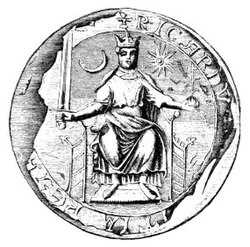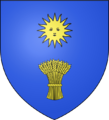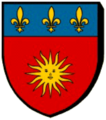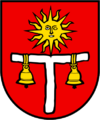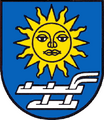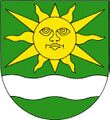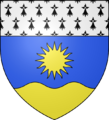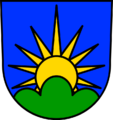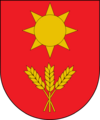Sun (heraldry)
 From HandWiki - Reading time: 3 min
From HandWiki - Reading time: 3 min

A representation of the sun is used as a heraldic charge. The most usual form, often called sun in splendour or in his glory, consists of a round disc with the features of a human face surrounded by twelve or sixteen rays alternating wavy and straight.[2][3] The alternating straight and wavy rays are often said to represent the light and heat of the sun respectively.[4]
It was used as a badge by Edward II of England, and was later adopted by Edward IV following the appearance of a parhelion or "sun dog" before his victory at the Battle of Mortimer's Cross in 1461.[3][5] It also had significance in alchemy, and may be a symbol of the Roman deity Sol Invictus (Unconquered Sun).[6]
It is a common charge in the heraldry of many countries, regions and cities: e.g. the bearings of Armstrong, Canada; the Sun in Splendour appears superimposed on the Cross of St. George and behind the White Rose of York on the flag of West Riding of Yorkshire; and on the arms of Banbury Town Council, England. It also often appears as a rising sun as in the arms of East Devon District Council , England, and as a demi sun as in the coat of Aitchison, Canada.
According to historian Diego Abad de Santillán, the Sun of May represents Inti, the Incan god of the sun, and thereby Inca culture.<ref>{{cite book| last = Abad de Santillán| first = Diego
Examples
- Sun in splendour, with face
- Arms of Basse-Terre
- Sun in splendour, without face
- Straight rays (mullet)
- Flag of Macedonia (Greece) (Vergina Sun)
- Wavy rays (estoile)
- Without rays (roundel)
- Other forms
See also
- Solar symbol
- Splendor Solis
References
- ↑ English heraldic tradition of the early modern period associates the star and crescent design with Richard, with his victory over Isaac Komnenos of Cyprus in 1192, and with the arms of Portsmouth (Francis Wise A Letter to Dr Mead Concerning Some Antiquities in Berkshire, 1738, p. 18). Heraldic tradition also attributes a star-and-crescent badge to Richard (Charles Fox-Davies, A Complete Guide to Heraldry, 1909, p. 468).
- ↑ James Parker, A glossary of terms used in heraldry. Accessed 13 December 2009
- ↑ 3.0 3.1 Dictionary of Vexillology. Accessed 13 December 2009
- ↑ Fox-Davies, A.C., (1969) A complete guide to heraldry. Aylesbury: Thomas Nelson and Sons. p. 222.
- ↑ Encyclopædia Britannica: Edward IV and the Alchemists. Accessed 13 December 2009
- ↑ Banbury Faith Trail. Accessed 13 December 2009
fr:Liste des meubles héraldiques#Soleil
 |
 KSF
KSF
